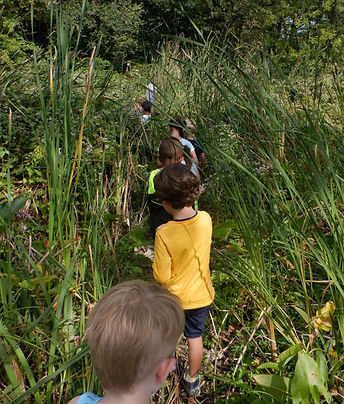How Does Nature Support Learning?
As early childhood educators, it is vital we are incorporating a variety of hands-on and kinesthetic experiences for our students. Our students learn best by doing, by singing, by moving, and by manipulating the resources and concepts.
Let's look at how two teachers are presenting lessons on animal homes. The first teacher will read a bunch of books on different animals and their habitats, show some pictures, and put out some plastic animals for students to interact with. The second teacher takes the class to the park, among the trees and woods, and has a discussion on what types of animals live there and the kind of homes they have. Students then choose a stuffed animal and found a place in the woods to build their animal’s home. Once everyone was complete, they did a gallery walk to observe and learn about each other's animal and their homes.
Which group of students do you think discovered the idea of animal homes more effectively? Right, the group of students with the second teacher! She made the lesson hands-on, used their own neighborhood/community as the background to their lesson, and gave the children options on what stuffed animal they are creating homes for. Sure, this could be done inside of the classroom too by bringing in nature items like sticks, leaves, and branches. However, being immersed in nature, in the same location as real animal homes we are studying, enables students to gain knowledge in a more meaningful and effective manner, as well as taking in all the benefits nature gives us such as the reduction of stress levels, increase in physical activity, and most importantly, the interest and enjoyment of learning (Kuo et al. 2019).
////////////////////////////////////////////////////////////////////////////////////
As humans, from all over the world, there are two things that keep us all interconnected: mother nature and our planet earth. Global climate change is not a new concept and is something that is not going away; quite the opposite is true. Therefore, it is becoming vital to adjust our daily behaviors in ensuring the protection of our Earth for generations to come (Sobel, 2008). The question becomes, how do we as educators support our students in becoming stewards of our earth? For many, it all starts with the nature experiences people have as children. As stated by Sobel (2008), there have been many environmentalists that state their allegiance to bettering our earth is from a blend of adults who taught them the meaning of respect for nature to the multitude of hours they have spent as children in unique and special places outdoors. Through the research, it illustrates the main way for educators to inspire students to become environmental stewards of our earth is to let them play in their natural surroundings (Sobel, 2008).
////////////////////////////////////////////////////////////////////////////////////
My motto has always been, what we can do inside the classroom walls, we can also do outside. We are able to tear down the walls and provide a larger and more expansive classroom for our students. Learning within nature imparts a less confining setting for learning compared to the traditional classrooms and allows students more freedom to interact with each other and form meaningful relationships (Kuo et al. 2019). Learning is cooperative and must facilitate comfort between the students and teachers. Learning about and in nature encourages the idea that the teachers are seen as partners in the learning process and not the gatekeeper of knowledge (Kuo et al. 2019). Nature also provides us with an endless number of resources to help our students uncover and explore the world around them. It is easily differentiated as it enables students to explore their own boundaries and discover what inspires them. Through these experiences, they are strengthening their critical and creative problem solving as well as fostering their imagination. As children, it is a place to explore, to go on adventures, to create small worlds in an effort to make meaning of their own world. It creates a space to discover their own boundaries, understand their interconnectedness to their world around them and to others, as well as a place to discover who they are. Learning in nature, learning about nature, and learning with nature supports all aspects of our students by providing a serene, relevant, and secure context for learning that exposes them to more real-life opportunities (Kuo et al. 2019). Nature provides a mellow and cooperative setting for learning that, with a combination of loose parts and autonomy, cultivates developmentally instrumental forms of play (Kuo et al. 2019).
////////////////////////////////////////////////////////////////////////////////////
If taking the classroom outdoors is new to you, start small and simple. Start by doing an activity, a read aloud, or a meeting. As you become more comfortable in nature, the students will too. Don’t give up. If the first time taking a hike or teaching a lesson doesn’t go as planned, reflect on it and change it up next time. Each day you spend more time outside, the more comfortable and confident you will get with your capabilities. This is true for the students as well. I have seen firsthand how students’ confidence and sense of self has grown by being able to navigate, explore, problem solve, and be creative in nature. These factors will undoubtedly follow the students into their academic and social realms. The 21st century skills, behaviors, and attitudes needed to be successful in our society such as self-efficacy, resilience, social skills, communication skills, perseverance, and leadership are located in the experiences with nature (Kuo et al. 2019).

Nature is a tool to get children to experience not just the wider world, but themselves.
-Stephen Moss




References
Kuo, M., Barnes, M., & Jordan, C. (2019). Do experiences with nature promote learning? Converging evidence of a cause-and-effect relationship. Frontiers in Psychology, 10(305), 1-9. https://doi.org/10.3389/fpsyg.2019.00305
Moss, S. (n.d.). 30+ quotes about children and nature that will inspire outdoor play. Little Pine Learners. https://littlepinelearners.com/30-quotes-about-children-and-nature-that-will-inspire-outdoor-play/
Sobel, D. (2008). Childhood and nature: Design principles for educators. Stenhouse Publishers
